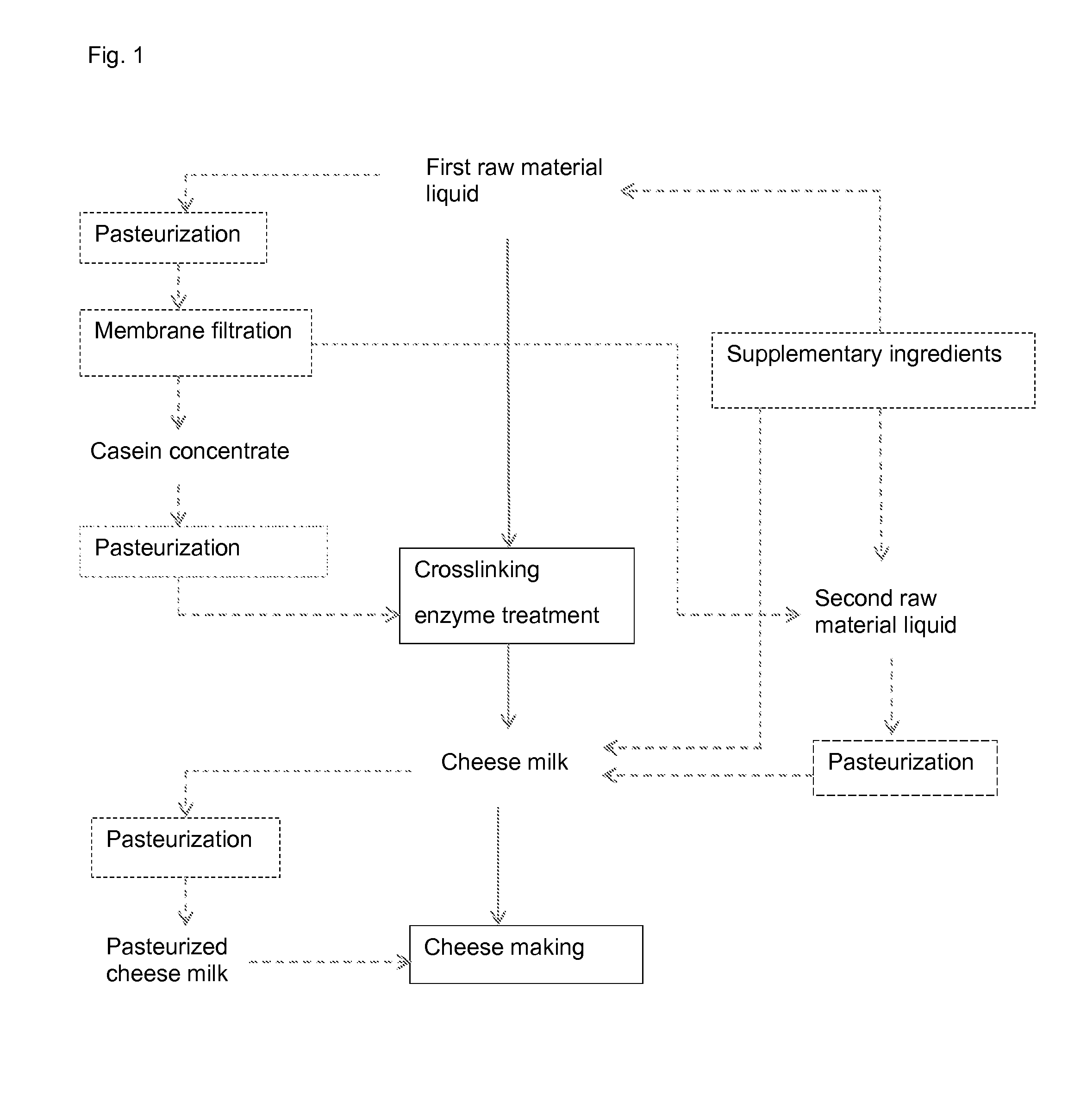Cheese and preparing the same
a technology for preparing cheese and cheese, which is applied in the field of cheese making, can solve the problems of unfavorable organoleptic properties of whey proteins, especially taste, and achieve the effect of improving yield and good organoleptic properties
- Summary
- Abstract
- Description
- Claims
- Application Information
AI Technical Summary
Benefits of technology
Problems solved by technology
Method used
Image
Examples
example 1
[0078]Skim milk was concentrated with ultrafiltration to a concentration factor of 3.3 and to a protein concentration of 12%. The concentrate was heated to 15° C., and 3 U / g, based on protein of the concentrate, of transglutaminase was added. The concentrate was incubated at 15° C. for 3 hours. After incubation cheese milk was standardized with 7% by volume of cream, 85% by volume of skim milk and 8% by volume of the concentrate to a protein content of 4.2% by weight and fat content 2.94% by weight. After standardization, cheese milk was pasteurized at 72° C. for 15 s.
[0079]Cheese milk was heated to 33° C. and 0.005% by weight of DVS-R608 (Hansen) and 0.002% by weight of CHN19 (Hansen) starter cultures were added. After 1 hour incubation, 0.08% by weight of CaCl2 and 0.005% by weight of chymosin were added, and after 30 min incubation coagulated cheese milk was cut to small cubes and cheese curd was formed. Curd was cooked in a cheese vat for one hour. After mixing, whey was removed...
example 2
[0082]Skim milk was heated to 40° C. and it was treated with 2 U / g, based on protein from skim milk, of transglutaminase and incubated for 15 min. After incubation, cheese milk was standardized with 5% by volume of the above skim milk treated with transglutaminase, 90% by volume of skim milk without transglutaminase treatment, and 5% by volume of cream. The resultant cheese milk was pasteurized at 73° C. for 15 s.
[0083]After cooling, cheese milk was heated to 33° C. and 0.005% by weight of DVS-R608 (Hansen) and 0.002% by weight of CHN19 (Hansen) starter cultures were added. After 1 hour incubation, 0.08% CaCl2 and 0.005% chymosin were added and after 30 min incubation coagulated cheese milk was cut to small cubes and cheese curd was formed. Curd was cooked in a cheese vat for an hour. After mixing, whey was removed, and curd was moulded, pressed and brined. Cheese was ripened for 4 weeks at 12° C. Control cheese was prepared accordingly without crosslinking enzyme treatment.
[0084]Ch...
PUM
 Login to View More
Login to View More Abstract
Description
Claims
Application Information
 Login to View More
Login to View More - R&D
- Intellectual Property
- Life Sciences
- Materials
- Tech Scout
- Unparalleled Data Quality
- Higher Quality Content
- 60% Fewer Hallucinations
Browse by: Latest US Patents, China's latest patents, Technical Efficacy Thesaurus, Application Domain, Technology Topic, Popular Technical Reports.
© 2025 PatSnap. All rights reserved.Legal|Privacy policy|Modern Slavery Act Transparency Statement|Sitemap|About US| Contact US: help@patsnap.com


